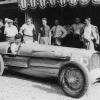
Leasing Cosworth engines in mid-1990s
#1

Posted 17 June 2011 - 06:18
Was this a common arrangement amongst all teams that used Cosworth engines in the mid-1990's? Did teams pay up front at the start of the season for use of the engines, or was Cosworth paid throughout the year. Could teams pay more to Cosworth and get more use from their leased engines?
Advertisement
#2

Posted 17 June 2011 - 08:58
#3

Posted 17 June 2011 - 10:03
#4

Posted 17 June 2011 - 10:29
One of the principal reasons why the Forti team folded in the middle of the 1996 Formula 1 season was because they were unable to pay for the use of the Cosworth engines in their FG03 model cars. From what I have read, Forti were in debt to Cosworth, and this eventually led to the cars arriving at the German GP, but not competing, as Cosworth cut off their right to use their engines due to the unpaid debts.
Was this a common arrangement amongst all teams that used Cosworth engines in the mid-1990's? Did teams pay up front at the start of the season for use of the engines, or was Cosworth paid throughout the year. Could teams pay more to Cosworth and get more use from their leased engines?
Racecar Engineering's report on Forti at the 1996 British Grand Prix:
"The parlous financial state of the Forti Grand Prix team was revealed by it's failure to start the British GP with either of its cars. The team has exclusive use of Cosworth's Zetec-R V8 engines in 1996 and the deal stipulates a maximum mileage between rebuilds. If this is exceeded by any engine, Cosworth can apparently levy an extra charge per kilometre of track use until the engine is submitted for servicing. It seems that Guido Fort's team went to Silverstone with only two engines ready to run, and without a budget to pay for rebuilds on both which were due in less than 20km of track use. The team therefore declined to participate in any of the practice sessions , but faced a fine of US$250,000 per car if it failed to attempt to qualify. Consequently, its drivers were instructed to take their cars out towards the end of the single qualifying session and to park them immediately after completing three laps - a distance of 15.2km. This action saved $500,000."
Edited by small block, 17 June 2011 - 10:30.
#5

Posted 17 June 2011 - 11:34
Racecar Engineering's report on Forti at the 1996 British Grand Prix:
"The parlous financial state of the Forti Grand Prix team was revealed by it's failure to start the British GP with either of its cars. The team has exclusive use of Cosworth's Zetec-R V8 engines in 1996 and the deal stipulates a maximum mileage between rebuilds. If this is exceeded by any engine, Cosworth can apparently levy an extra charge per kilometre of track use until the engine is submitted for servicing. It seems that Guido Fort's team went to Silverstone with only two engines ready to run, and without a budget to pay for rebuilds on both which were due in less than 20km of track use. The team therefore declined to participate in any of the practice sessions , but faced a fine of US$250,000 per car if it failed to attempt to qualify. Consequently, its drivers were instructed to take their cars out towards the end of the single qualifying session and to park them immediately after completing three laps - a distance of 15.2km. This action saved $500,000."
A similar limitation was put on the NME V8s in hillclimbing. The engine management system was provided by NME and they would occasionally turn up events with new units to swap out. The old units went back and if the engine had been over-revved more than the allowed number of times then a MANDATORY rebuild at the driver's expense was required. Engines had to be rebuilt after a fixed number of hours running so the guys who shared a car had to have their engine rebuilt more frequently. All but one of the engines that were leased ended up being bought by the drivers at the end of the lease period. One engine was 'repossessed' at the end of the lease period.












